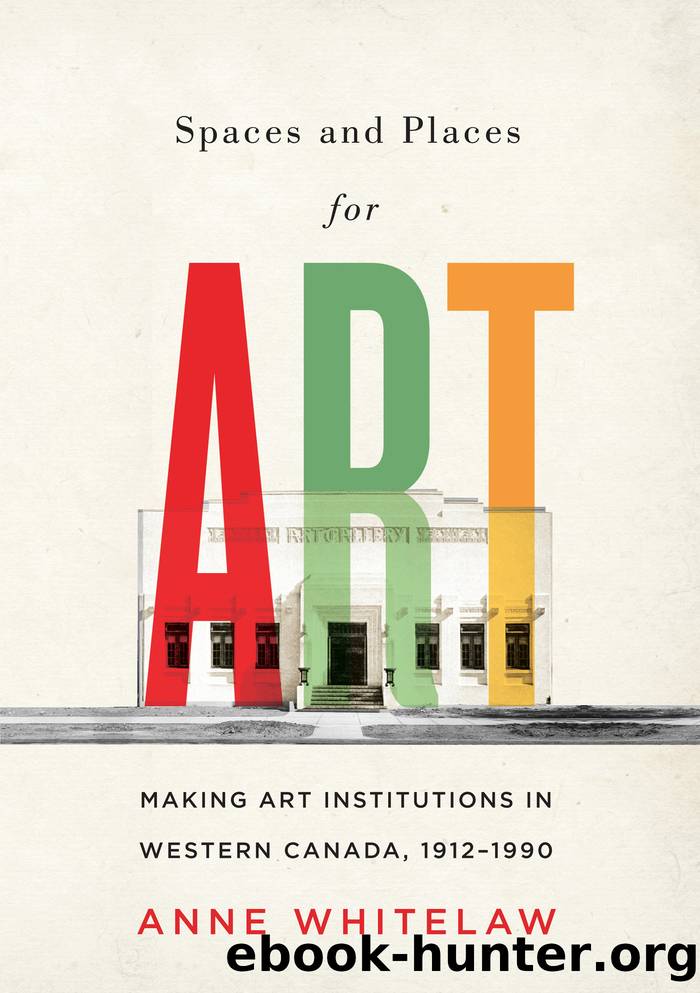Spaces and Places for Art by Whitelaw Anne;

Author:Whitelaw, Anne;
Language: eng
Format: epub
Publisher: MQUP
Published: 2017-09-14T16:00:00+00:00
The National Gallery Reasserts Itself: The 1958 Regina Conference
If the discussions during the Vancouver conference attempted to address the spectre of the National Galleryâs paternalism and centralization, the issue was effectively dealt with some eighteen months later as the NGC organized another conference of representatives of art galleries and art associations, focusing this time exclusively on organizations from western Canada. Held on 12 and 13 April 1958 at the Norman MacKenzie Art Gallery, the Regina conference was a carefully managed affair intended to establish the National Galleryâs newly formed Exhibition and Extension Services department as the primary decision maker in the circulation of exhibitions in western Canada, if not completely replacing the WCAC, then wresting control over much of the movement of exhibitions throughout the region. Since its formation in 1957, the extension department had developed a uniform fee structure for circulating exhibitions that included a sliding scale of charges to individual galleries based on population. As described in the NGCâs 1956â57 Annual Report, the new structure would benefit art galleries in cities with a population of less than one hundred thousand,42 a doubtless welcome change for the many small centres that continued to spring up all over the country. From its inception, the department took over the coordination of all exhibitions organized by the NGC for circulation, developing a range of shows that catered to the diverse needs of exhibiting centres across the country. Writing in 1958, Norah McCullough described the role of the liaison or field officers as âwork[ing] closely with local galleries, ascertaining the types of exhibitions needed and [being] ready to give expert advice on programming and the installation of exhibitions.â43 As this statement suggests, the new approach to circulating exhibitions in western Canada involved direct contact between the NGC and individual galleries regardless of size or characteristic, with circuits playing a secondary role in the departmentâs plans.44 Indeed, McCullough notes that liaison officers âwill attend the meetings of the various regional art circuits to evaluate criticism and suggestions and also to bring the views of the National Gallery to the direct attention of the circuits.â45
In the months leading up to the Regina conference, tensions between the WCAC and the department of extension were already apparent in correspondence between the circuitâs director Archie Key, Extension Director Richard Simmins, and Western Liaison Officer Norah McCullough as Key continued to seek funding for the WCAC and complained about the quality of Extension exhibitions. As Simmins and McCullough prepared the agenda for the conference and discussed which delegates would be invited to attend, their frustration with the demands of the WCAC were evident. As the galleryâs western representative and having just completed a tour and evaluation of art centres in the four provinces, McCullough was forthright in her assessment of potential delegates, particularly in terms of where they might position themselves in relation to the WCAC and its erstwhile director, Archie Key.46 For McCullough and Simmins, the goal of the conference was to establish a more efficient means of circulating exhibitions throughout western Canada.
Download
This site does not store any files on its server. We only index and link to content provided by other sites. Please contact the content providers to delete copyright contents if any and email us, we'll remove relevant links or contents immediately.
Wonder by R.J. Palacio(7732)
Unlabel: Selling You Without Selling Out by Marc Ecko(2981)
POP by Steven Heller(2885)
Hidden Persuasion: 33 psychological influence techniques in advertising by Marc Andrews & Matthijs van Leeuwen & Rick van Baaren(2778)
The Pixar Touch by David A. Price(2740)
Ogilvy on Advertising by David Ogilvy(2683)
Drawing Cutting Edge Anatomy by Christopher Hart(2678)
Slugfest by Reed Tucker(2417)
The Art of War Visualized by Jessica Hagy(2412)
The Curated Closet by Anuschka Rees(2385)
Stacked Decks by The Rotenberg Collection(2270)
The Wardrobe Wakeup by Lois Joy Johnson(2235)
365 Days of Wonder by R.J. Palacio(2233)
The Code Book by Simon Singh(2210)
Rapid Viz: A New Method for the Rapid Visualization of Ideas by Kurt Hanks & Larry Belliston(2195)
Tell Me More by Kelly Corrigan(2195)
Keep Going by Austin Kleon(2161)
Tattoo Art by Doralba Picerno(2083)
Tokyo Geek's Guide: Manga, Anime, Gaming, Cosplay, Toys, Idols & More - The Ultimate Guide to Japan's Otaku Culture by Simone Gianni(1947)
